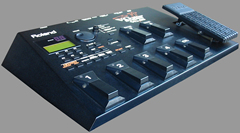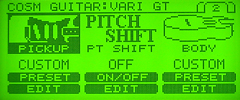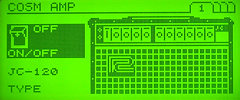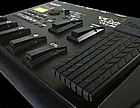| |
| INTRODUCTION |
 |
 |
Since
the middle '70's many manufactures tried to give the guitar players
the possibility to expand the timbral palette and the expression
level of the electric guitar thru synthesized sounds.
Roland is one of the leader in this field in terms of continuity
and quality of the systems released on the market. The company started
introducing the GR series and then, in the middle '80's, continued
to produce a wide range of MIDI converters.
At last, in 1995, Roland introduced a new revolutionary product:
the VG8. For the first time, being based on advanced DSP technology,
the VG8 allowed to use the guitar strings vibrations to generate
the sound, eliminating the limits of the MIDI conversion.
The problems of the previous "guitar-synths" generation (delay,
notes drift, lack of sensibility to the expressive nuances of the
performer's playing style) were solved at last. The VG-8 allowed
both to create completely new original sounds and to reproduce the
most common guitar-amplifier systems by combining various modeling
techniques.
Featuring improved technology, new timbral possibilities and a better
user's interface, the VG-88 is the last result of Roland VG technology.
 Technical
Details Technical
Details
|
| MAIN
PLUS |
 |
| |
Technology
All the acoustic, electric and magnetic elements generating the
guitar sound are included into the VG-88 as "models" that can be
combined during the sound programming. This Roland technology is
called COSM (Composite Object Sound Modeling).
|
| |
 |
COSM
Guitar
In the COSM Guitar section it is possible to select:
- the instrument type: acoustic,electric, solid-body or hollow-body;
- the tuning: each string can be tuned individually thanks to the
GK-2A hexaphonic pickup;
- the pickup type: magnetic, single coil or humbucker (different
types and customizable configurations), or piezo;
- the equalizer.
The VG-88 provides a large number of algorithms that emulate the
ordinary guitar sounds or allow to create completely new sounds
that is impossible to obtain from a traditional system.
An example is the polyphonic distortion, where each string is distorted
individually. Polyphonic distortion allows to play harmonically
complex and heavily distorted power chords with distinctive harmony.
A large number of synthesis algorithms is also available where the
guitar string is still the sound source. The waveform created by
the string vibration is processed to become brass, synth bass, strings,
woodwind, metal and so on.
|
| |
 |
The
VG-88 provides a large number of algorithms that emulate the ordinary
guitar sounds or allow to create completely new sounds that is impossible
to obtain from a traditional system.
An example is the polyphonic distortion, where each string is distorted
individually. Polyphonic distortion allows to play harmonically
complex and heavily distorted power chords with distinctive harmony.
A large number of synthesis algorithms is also available where the
guitar string is still the sound source. The waveform created by
the string vibration is processed to become brass, synth bass, strings,
woodwind, metal and so on.
The COSM Guitar is a polyphonic section: in order to control this
section it must be installed a Roland GK-2A pickup or equivalent
(i.e.: the divided pickups mounted on the guitars manufactured by
Godin, Fender, RMC, Yamaha and others).
"Polyphonic section" means that this part of the VG88 is able to
process the vibrations of each string individually, while the normal
electric guitar (even if generates a polyphonic sound) sends the
mixed strings signals to a monophonic output.
Thanks to this feature,the COSM GUITAR section allows to mix the
strings sound individually. For instance, each string can be panned
individually in the stereo image.
|
| |
 |
COSM
Amp
Once the instrument has been created (guitar or anything else),
it's important to combine it with a suitable amplifier. Any player
knows that the final sound of his guitar mainly depends on the amplifier.
We can say that the amplifier and the guitar deeply interact together
to become a single instrument, as happens for the strings and the
resonance body of an acoustic instrument.
The COSM Amp section provides a wide range of amplifiers and speakers
featuring the original controls.
There is also the possibility to set the virtual position of the
microphone (near or far, in front of the speaker or angled) and
to balance the direct and microphone sounds.
|
| |
 |
Effects
This section features a wide range of effects: all the most common
BOSS pedal effects are included providing a variety of options.
One of the strong points of the system is the free setting of the
amplifier-effects chain: it is possible, for instance, to place
compressor and wah before the amplifier (to better control tone
and overdrive) and then to process the amplifier output - yet "miked"
- by the other effects, faithfully reproducing a typical recording
studio setup.
Unlike the previous VG-8 model, the VG-88 allows to use the COSM
Amp and Effects sections with the built-in guitar pickups too.
Real-Time Control
Besides the built-in pedalboard (that allows a direct selection
of banks and patches), the VG88 also features a [CONTROL] foot switch
and an assignable expression pedal. This one allows a real time
control of volume, wha, pick-ups blend, pitch shift and so on.
Memory and MIDI Control
The VG-88 provides 100 User + 160 Preset Programs. They can be directly
recalled thru the built-in pedalboard or via MIDI.
Eight continuous controls can be assigned to as many parameters
that can be programmed and stored in each patch individually. MIDI
Maps and Bulk Dump are also available.
It should be underlined that the VG-88 has been projected to directly
process the real strings sound in real time without any convertion
in pitch information. Therefore, the MIDI Out of the unit cannot
work as a MIDI converter.
|
| |
 |
Editing
Despite the sophisticated modeling-based engine and the wide range
of options, the VG-88 has been designed to be intuitive and easy
to use. The user interface, largely based on graphic icons, is agreeable
and attractive for programming.
All sections can be selected thru a dedicated key, allowing the
user a quick and easy switching from a section to another one. A
full range of preset parameters (that can be edited when required)
and a EZ Edit function (programming simplified control) are available
for inexperienced or a bit lazy musicians.
Two things are important to get the best results: the right instrument
setup and the GK-2A pickup location with the relevant setting parameters.
.
|
| |
| CONCLUSION |
 |
| |
Any
guitar player will surely appreciate the Roland care in projecting
this instrument and its user's interface.
All of the original expressive nuances of the performer's playing
style remain intact.
Besides the large number of emulation possibilities, the synthesis
function represents a further interesting feature, that can be controlled
in a better and flexible way in comparison with the previous VG-8
model.
Therefore, it's obvious that the VG-88 can be useful both to create
new sounds in studio and to facilitate the required instrument setup
in live performances.
The VG-88 is not just an effect unit, but it's a real musical instrument:
interesting to discover, stimulating to play. |
|
|
|
 |



